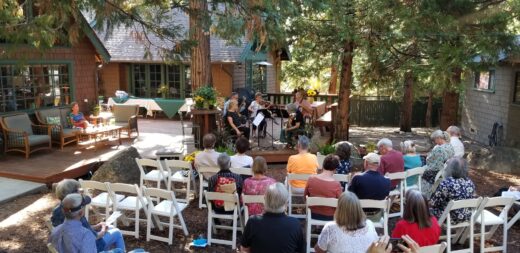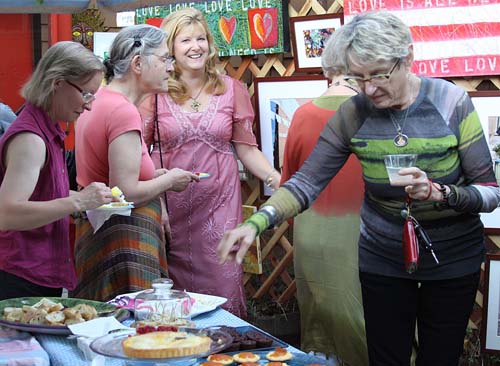By Art Connor
Music Reviewer
In recalling the past few months of both fateful and less world-shaking events, it comes as almost a relieving reprieve for this reviewer to reflect on the missing opportunities for live music in a community so favored and well-respected for those causes. So at a particularly salient moment, here at the transition to early autumn on the Hill, it happened that a premier event was scheduled as a renewal of activity in this area, when the Associates of Idyllwild Arts Academy presented their annual Fall Musicale as an outdoor benefit concert in support of the school’s activities.

PHOTO BY THOM WALLACE
Sept. 5, Sunday’s concert, was certainly intended to put forth a variety of musical styles, as well as to slake any thirsts accorded by the performance drought, and the usual complement of performers — the Speltz and Levy families, plus guest artists — were on hand to provide a firm sonic background to the well-situated woodland setting.
Returning after that enforced year’s absence, solo flutist Lisa Edelstein began the program with a repeat rendition of Claude Debussy’s “Syrinx” in an even more nature-inspired performance than previously essayed; perhaps also affecting the resounding of the area’s bird calls. Following that introduction, the special featured guest artist, violist Luke Fleming (on temporary refuge from hurricane-harried New Orleans) entertained the attendees with a rewarding version of the main movement of Beethoven’s “Duo for Viola and Cello” as an introductory taste of string sound, in addition to presenting the composer’s calling-card for one of his early important Viennese patrons.
Somewhat more rewarding string sonics were accorded in the rendition of a single movement from one of the Fantasias of Henry Purcell, where the total effect of dissonances and their resolutions were brilliantly achieved (as in many a fantasy) by coordinate ensemble playing.
The next two programmed items revealed the true nature of such ensemble work; the short movement from Schubert’s unfinished “String Trio in B-Flat Major” proved eminently songful in spirit (possibly because the composer’s lieder-writing period had just come to the fore), and Ms. Edelstein’s joining of the string players for the “Flute Quartet in D Major” of Mozart (all three movements) provided an exquisite and relaxed opportunity for coordinated ranges of sound to be enjoyed.
There followed the main movement of Zoltan Kodaly’s “Duo for Violin and Cello,” a work of modern instances of tonal stress somewhat the equivalent of the Purcell Fantasia, but far more revelatory of early 20th century Central European stresses. Executed again with a penetrating string sonority, the work brought forth the composer’s struggle to find reconciliation between folk styles and more classical modes of expression.
The two excerpts from Maria Newman’s “Colores de Mexico” suite for solo flute once again brought Ms. Edelstein’s talents to the fore: the movement “The River” evoked all the swirls and clashes of watery motion, with subtle dashes of Latinate rhythms, and “The Coyote” movement was a similarly subtle picture of a lonely wilderness animal, with as mournful a cry as can be managed by the flute’s treble register.
For a somewhat necessary reflective as well as effective conclusion to the proceedings, the principals — violinist Connie Kupka, violist Jane Levy and cellist David Speltz, further bolstered by the foundation provided by guitarist Douglas Gerry — embarked on a meditative rendition of Jay Unger’s “Ashokan Farewell” which understated the somewhat cliched folk phrasing, thus ending a presentation satisfying both mind and ear.
Certainly the Associates are to be commended in whatever way possible for such events, and the student and patron participations in the event are equally worthy of congratulations.





